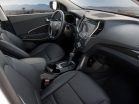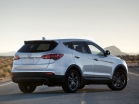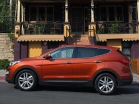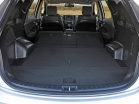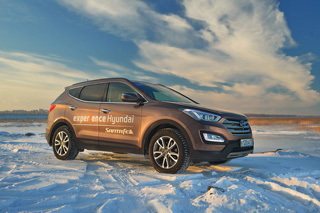Hyundai Santa Fe Test drive since 2012 SUV
Frounded "SUV"
Updated Hyundai Santa Fe: They are not looking for good from good ...Hyundai Santa Fe has been updated, and it is clear why. Firstly, the age in the market has been five years old, and secondly, after the appearance of the younger Tucson, this measure was completely necessary. SUVs are similar as brothers both outside and the same engines, transmission units, internal sizes and, of course, price. In fact, they became the main competitors for each other, which raised many questions. The plastic surgery, in theory, was supposed to weaken the rivalry somewhat, making the advantages of Santa Fe more significant, but, as it turned out, the leadership of Hyundai had a different opinion.
At the first, and in the second glance, this is all the same Korean familiar to everyone with the same doused wings, a massive head optics, and a relief hood. The body profile remained unchanged, thanks to large overhangs, something reminiscent of the station wagon. To notice the immediate traces of facelifting is quite difficult, they are so insignificant. In fact, only the rear lights did not change at all plastic surgery (and they are simply arranged differently) and a false radiator grille. Inside the changes, even less Santa Fe received only an updated instrument panel.
Nevertheless, this did not prevent the Koreans from raising the cost of the SUV by almost 1000 evergreen. Thus, about $ 34,500 will have to pay for the car in the top execution of GLS. However, for this money, the buyer still receives a well-soiled car. In addition to the standard two frontal airbags, a power steering, central lock, immobilizer, as well as a set of electronic systems ABS, EBD and LSD (as an additional option, you can also order the TCS course stability system), the car will have decent quality leather interior, Completely electrified glass and mirrors (the latter with heated, however, like the front seats and wiper brushes), climate control with an dust filter, an on-board computer and 16-inch alloy wheels. Perhaps the only thing that is missing in Santa Fe is a branded audio system.
Naturally, the Korean SUV remained the same from the point of view of ergonomics and the capacity of the cabin. In principle, anyone will fit in the workplace, but because of a somewhat limited range of adjustments of the seat and steering wheel (the column moves only in height), tall people will have to put up with an unusual vertical landing and, as a result, a lack of free space at the top. There are much fewer complaints about passenger places. In addition to the driver in the cabin, four more people will be accommodated without problems, they can sit more freely, so there will be plenty of free space for the knees and for the head. Another advantage of decent sizes of the trunk, where 850 liters of cargo easily fit, and if you completely fold the back of the rear sofa, then you will increase to 2100 liters, you will agree, it is not bad for a budgetary SUV.
The line of power units is also unchanged. Official dealers of choice can offer Santa Fe with three engines with a 2-liter 112-horsepower turbodiesel and two gasoline engines: a 2.4-liter in-line four, developing 150 hp, and a top-shaped V-shaped six-capacity of 173 horses. The last option was installed on a test car.
This motor can show character, and regardless of the transmission aggregated with it. In our case, we are talking about a 4-speed adaptive machine with the possibility of manual switching (there are more budgetary, but also more frisky cars with a manual transmission on sale), which operates in a very interesting algorithm. Like the units similar to him, with a sharp press on the pedal, he naturally goes to a reduced gear. However, if the pedal is drowned twice, then he will jump through two steps, making acceleration even more dynamic. By the way, in manual mode, the machine also allows you to promote the engine almost before cutting off.
Nevertheless, the main advantage of this engine is economy. If you trample the gas pedal, as they say, without fanaticism, then in the city you can easily achieve a consumption that barely breaks out of 14 liters per hundred, and for 100 kilometers of the route 1675-kilogram SUVs and completely burns a little more than 11 liters of gasoline. Moreover, the 92nd. The system of all -wheel drive, which deserves a separate mention, is also played here, such economicality is also played because the car under normal conditions has a front -wheel drive, and the rear wheels are connected through Viskyoft only when slipping.
By the way, Santa Fe is equipped with a very good set of off -road options on it is regularly installed a self -locking asymmetric center differential, dividing the torque between the front and rear wheels in a proportion of 60:40. And for additional money, you can order the installation of the rear inter -axial differential of increased friction for the conquest of this off -road is not enough, but for a car of this class there are more than enough, many of its competitors do not even have this.
Santa Fe remained the same large, quite powerful, but budgetary parkingate, which is generally not bad. However, returning to the above, such conservatism of the Koreans is still incomprehensible. Almost the only difference between Santa Fe and Tucson remains their appearance if the elder is more implicant and clearly designed for an overseas buyer, the second is more focused on the old light. Leaving a couple of almost identical SUVs on the Russian market, at least unreasonably, they will continue to compete primarily with each other. However, this is the subjective opinion of the author of these lines, and the Hyundai marketer seems to have other views.
You can see this pseudo -sorcerer on the other side of Santa Fe originally one of the best offers in the classroom, and, as you know, they are not looking for good from good. A serious alteration would require significant financial injections. Which, in turn, would invariably entail a noticeable increase in the final cost of the machine. What for such, in general, a budget brand, like Hyundai is inaccessible, especially when it comes to our market, where the buyer most often votes with a ruble.
Text: Vladimir Zhidkov
A source: Mkobil magazine [04/25/2005]

